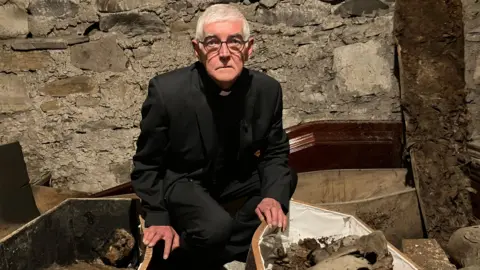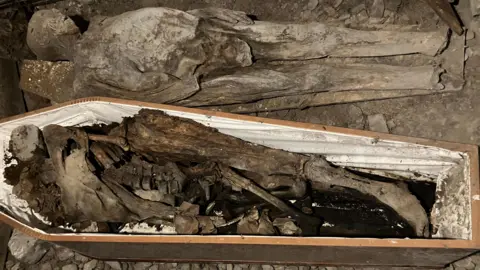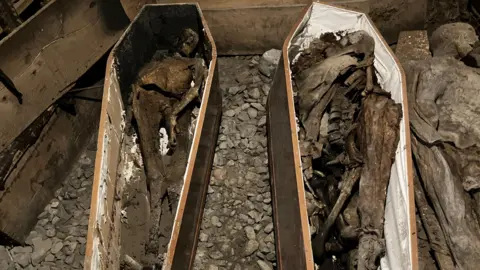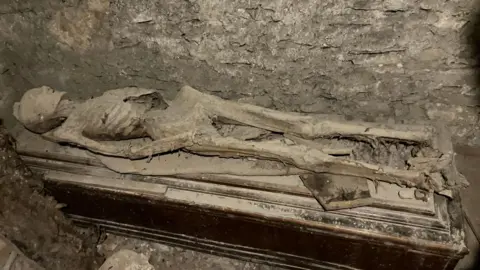BBC News or Dublin Reporter
 Bbc
BbcAn Anglican Church of Dublin was unable to reopen a historic crypt to the public because the remains of mummified bodies were damaged during a criminal fire.
One of the damaged mummified bodies of the Church of Ireland of St Michan is that of a man, known as Crusader, who died about 800 hundred years ago.
A 39 -year -old man, Cristian Topiter, who had an address in Grand Canal House, Lower Rathmines Road, Dublin 6, was imprisoned for six years last month.
He had pleaded guilty to the 2024 criminal fire attack which the Church described as “an act of desecration and sacrilege”.
More than nine months after the attack last June, the crypt remains outside the limits to visitors and tourists.
The main entry doors of the St Michan church land are closed and locked.
Inside the field, a heavy steel cover and a steel door leading the crypt are also locked.
‘Irreparable’

The church facilitated a visit to the site by BBC News Ni.
“As a parish, as a vicar of the parish and as parishioners, we are the guards of the whole church,” said archdeacon David Pierpoint.
“Not only above the church, but what is happening below the church, and it is a rather heavy burden to bear.”
Talk about damage to the estimated remains of 800 years of the Crusader.
He explained: “his whole body was charred, the spine, his hands, one of his legs is completely missing, and there is a lot of damage.”
The vicar of St Michan’s said that the damage caused to the remains of the crusader and the remains of another man, who would have been buried alive about 400 years ago, is “irreparable”.

The closure of the church for most of the last year caused a significant drop in parish income because the church had no choice but to prevent tour groups from visiting until the remains were removed.
Thousands of people generally visit the church every year.
The Archdeacon Pierpoint hopes that the groups will soon be able to return once the authorization granted by the diocesan authorities and the Dublin municipal council for the reinterposes.
The vicar of St Michan’s says that it is important to reopen the crypts as soon as possible to ensure that the church has sufficient funds to maintain the church of centuries
But, he said, it is also important to allow visitors to their homes and abroad “to see the phenomenon of what it really is”.
Most of the current buildings in St Michan date from the 17th century, with the exception of the 12th century tower.
Crusader beheaded in 2019

The attack on criminal fires last summer has been one of the many incidents in the past few years in which the Church and the Crypt have been targeted.
In 2019, the Vandals burst and beheaded the crusader.
The skull was then recovered and delivered with the help of the National Museum of Ireland neighbor, according to the Archdeacon Pierpoint.
The crypt was also damaged in another interruption, also in 2019, and the Church said at the time that several mummified remains – including the remains of 400 years of a nun – had been desecrated.

The crypts of the Church of Ireland are also the place of rest of the lawyers Henry and John Sheares, two brothers who were leaders of the United Irish during the rebellion of 1798.
The site includes a copy of their execution order issued by the English authorities in Ireland at the time.
According to the church, all the mummified remains in the various crypts, with the exception of the crossroads, are people who died between 400 and 450 years, depending on the church.
Despite the current restricted access to the church terrains, St Michan’s remains open to worship every Sunday.
What is the story of St Michan?

The first church on the site would have been established in 1095, but the current church dates back to the 1680s with new renovations taking place between 1723 and 1725, in 1767 and 1825.
It was restored in 1998.
The remains of many most influential families in Dublin in the 17th, 18th and 19th centuries are also buried in St Michan’s.
It is believed that the limestone walls of the crypts and the atmosphere would have helped to preserve the remains.
The church organ is housed in the case of an organ case built by John Baptiste Cuvillie around 1725.



